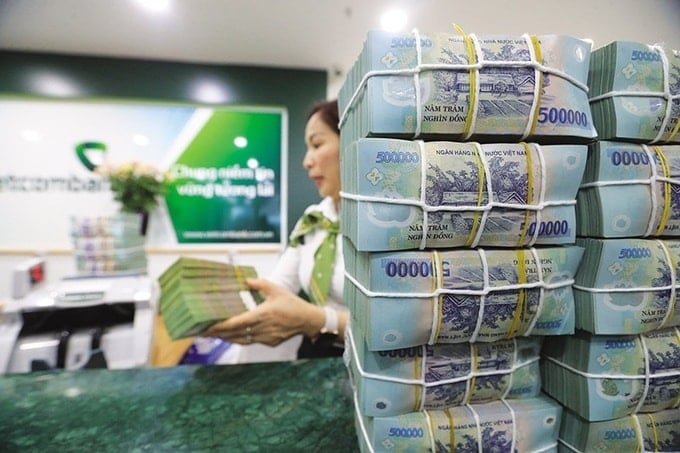The sharp decline in NIM could not stop the profit growth of many banks, as after only the first half of the year, a series of banks earned tens of thousands of billions of VND, some reaching record levels.
Positive Profit
According to analysts, there is a clear differentiation in net interest margin (NIM) among banks. Large-scale joint-stock banks such as VPBank and HDBank have recorded NIMs maintained at over 5%, even approaching 6% at times. In contrast, many small-scale banks only achieve NIMs below 2%.
As of the afternoon of July 31, 24 banks had announced their business results for the second quarter and the first 6 months of 2025. Of these, 6 banks reported profits exceeding VND 10,000 billion, reflecting a period of positive growth in the entire industry.
Military Bank (MB) is temporarily leading in terms of profit with a figure of more than 15,500 billion VND. Next is BIDV with pre-tax profit reaching 15,200 billion VND. VPBank recorded a profit of more than 11,200 billion VND, while Techcombank reached 15,135 billion VND. ACB also reported high profit with 10,690 billion VND, while HDBank achieved a profit of 10,068 billion VND.
In the group of smaller banks, many units still achieved impressive profits in the first 6 months of the year. SHB reported a profit of more than VND8,900 billion, LPBank reached VND6,164 billion, TPBank exceeded VND4,100 billion. Nam A Bank recorded a profit of more than VND2,500 billion, Sacombank reached VND3,657 billion, and ABBank earned VND1,669 billion.
It can be seen that the business results of the second quarter and the first half of 2025 of the banking sector still show a positive trend, despite the continued decline in NIM of the entire industry. Data from the Wichart platform shows that, by the end of the first quarter of 2025, the average NIM of 27 banks listed and registered for stock trading on the stock exchange was just over 3%. This figure has decreased compared to 3.11% in the fourth quarter of 2024 and is the lowest level since the fourth quarter of 2020. The trend of declining NIM has been continuous over the past two years.
For example, at MB, NIM in the first 6 months of the year was only 3.6%, lower than the 3.8% in the same period last year. Eximbank also showed a similar trend, when NIM in the second quarter was estimated at about 2.4%, only slightly up from 2.3% in the first quarter, but still much lower than 2.8% in 2024. This is one of the commercial banks with the lowest NIM in the system.
Previously, many analysis organizations predicted that the NIM of some banks would be flat in the second quarter. Specifically, MB Securities Company (MBS) estimated VPBank's NIM at about 5.9%, unchanged from the previous quarter but down from the same period last year. Meanwhile, SSI Securities Company said that ACB's NIM would not fluctuate much in the short term.
One factor affecting net interest margins is the pressure to reduce lending rates, especially in the state-owned banking sector. With the leading role in macroeconomic stability, these banks are often cautious in expanding retail credit, thereby limiting the ability to improve NIM. Meanwhile, private banks have an advantage thanks to the good growth in non-interest income in the first half of this year.

Where do bank profits come from?
Although net interest margins (NIMs) continued to narrow due to pressure from lower interest rates, many banks still recorded huge profits in the first half of 2025, mainly thanks to strong credit growth and consolidated financial buffers after many years of restructuring.
According to statistics, as of June 30, 2025, the entire system's credit had increased by nearly 10% compared to the end of 2024, an increase 2.5 times higher than the same period last year. In the context that the State Bank set a credit growth target of 16% for the whole year, equivalent to injecting an additional VND 2.5 million billion into the economy, the first half of the year's figures show that the room to complete this target is very positive.
Some banks have outstanding credit growth rates, such as MB with an increase of 12.5% compared to the end of 2024. At Kienlongbank, outstanding customer loans as of the end of June reached more than VND 69,547 billion, up 13.2%. Meanwhile, NCB reached nearly VND 86,835 billion in outstanding loans, up 22% over the same period last year and completed 90.4% of the yearly plan.
Experts say that credit demand is recovering strongly thanks to the positive economic outlook, the return of private investment capital and support policies from the Government. Mr. Nguyen Quang Ngoc, Deputy Head of Agribank's Credit Policy Department, said that in the process of granting credit, banks are proactively calculating scenarios and allocating capital with a focus, prioritizing the fields of production, export, technology and agriculture, while strictly controlling credit risks.
Another factor supporting profit growth is the positive progress in handling bad debts. After Resolution 42 of the National Assembly was "legislated" through the Law amending and supplementing a number of articles of the Law on Credit Institutions, banks have a more solid legal basis to handle secured assets and recover debts, thereby reducing the bad debt ratio and risk provisioning costs.
After many years of restructuring, the banking system has been significantly strengthened. Capital buffers have been increased, some weak banks have been forced to transfer, and the ability to withstand economic shocks has been significantly improved. Bad debts have tended to decrease, liquidity in the system is abundant, and interest rates are low, all of which create favorable conditions for credit growth to increase by about 10% in the second half of the year without causing system instability.
The banking industry’s profit forecast continues to be positive. Mr. Nguyen Trong Dinh Tam – Deputy Director of Analysis, Asean Securities Company – said that pre-tax profits of listed banks could increase by 15-17% in the last 6 months of the year, in line with the scenario of credit growth reaching 16% for the whole year. In addition, the bad debt ratio of the whole industry could decrease by about 0.3 percentage points, to 2.5%, especially thanks to the effective handling of secured retail debt.
It can be seen that, although NIM has declined in the context of low interest rates, banks still have the basis to achieve high profits thanks to strong credit growth, effective bad debt handling and a financial foundation that has been firmly consolidated after many years of reform.
Source: https://baolamdong.vn/bien-lai-thu-hep-loi-nhuan-ngan-hang-van-but-pha-386235.html




































































































Comment (0)